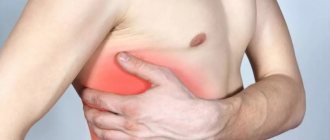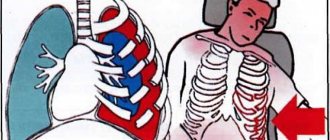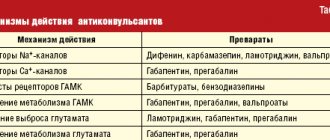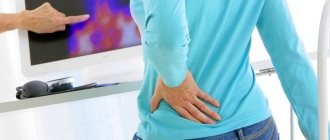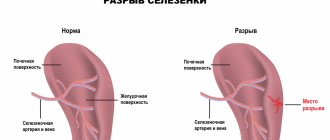Osteochondrosis is a very dangerous disease. It occurs unnoticed, and from mild uncomfortable sensations develops into serious disorders of the spine, which sometimes result in disability.
This disease is treated by therapists, neurologists, orthopedists, vertebrologists and other specialists at the Yusupov Hospital.
Why is thoracic osteochondrosis called a “chameleon”?
The thoracic spine has a special feature - the ribs are attached to it. Thanks to this, it is less mobile than the neck and lower back. Consequently, osteochondrosis in the thoracic region develops less frequently, according to the principle: “less mobility - less wear.” But it develops less often - this does not mean it proceeds easier. And indeed it is. We are talking about chest pain. Since the pain area of the thoracic spine coincides with the area of the heart, symptoms are often confused with angina pectoris or myocardial infarction. It is not for nothing that they say about thoracic osteochondrosis that it is a “chameleon”. After all, he can pretend not only to have a heart disease, but also a disease of the lungs, liver, stomach, gallbladder or pancreas. And here you can’t make a mistake and overlook a heart attack or other serious disease, for example, pathology of the mammary glands in women. Such mistakes are costly, even if everything works out in the end. After all, this can “drive” a person into severe stress. That is why it is very important to find an experienced and knowledgeable doctor who will understand everything and distinguish the symptoms of thoracic osteochondrosis from other pathologies. Symptoms of osteochondrosis of the thoracic region are usually divided into two categories - radicular and reflex.
Causes
The development of thoracic osteochondrosis is caused by an increase in the dynamic load on the spine as a result of upright walking. Prolonged static load, lack of varied movements, physical activity, eating refined foods containing large amounts of simple carbohydrates are the main factors that lead to the disease.
Additional reasons:
- general hypothermia,
- chronic stress,
- physical overload,
- hormonal imbalance,
- metabolic disorder,
- diseases of the musculoskeletal system,
- hereditary predisposition,
- overweight.
Radicular symptoms
They occur due to the impact on the nerves leaving the spine.
Spinal nerves
There are many nerves coming out of the spine. They are called spinal nerves. Each such nerve gradually branches and follows a specific area of the body with clearly defined boundaries. This area is called the zone of segmental innervation. Each vertebra, disc, nerve and zone are numbered, strictly corresponding to each other. If a nerve is exposed, the symptoms will appear in the zone of segmental innervation corresponding to that nerve, and not just anywhere - in an arbitrary place.
Radicular symptoms include:
- Decreased or lost reflexes;
- Impaired sensitivity;
- Muscle weakness;
- Radicular pain.
Innervation zones of the thoracic segments
Osteochondrosis D1–D2
- Causes pain in the shoulder, collarbone and armpit areas.
Osteochondrosis D3–D6
- causes pain of a girdling nature in the upper part of the chest. Simulates pain in the heart, an attack of angina. In women, it causes pain in the mammary glands.
Osteochondrosis D7–D8
- causes girdle pain at the level of the solar plexus. Simulates pain in the stomach, liver, gallbladder or pancreas. Reduces upper abdominal reflexes.
Osteochondrosis D9–D10
- causes pain in the hypochondrium and upper abdomen. Sometimes it imitates the so-called “acute” abdomen - sharp pain in the abdomen. Reduces mid-abdominal reflexes.
Osteochondrosis D11–D12
- causes pain in the groin area. Simulates pain in female diseases, appendicitis, and intestinal diseases. Reduces lower abdominal reflexes.
Diagnostics
In addition to conducting a thorough examination, your doctor may order the following tests to confirm the diagnosis:
- X-rays
help determine if there is joint degeneration, fractures, bone malformations, arthritis, tumors, or infection. - MRI
to determine morphological changes in soft tissues, including imaging of discs, spinal cord and nerve roots. - CT
scan, which can provide cross-sectional images of spinal structures. - EMG
, this diagnostic method is used to determine nerve damage and the level of damage - Myelogram
, as a rule, this research method is necessary to clarify the morphological changes in the degree of impact on the roots and spinal cord and plan surgical intervention.
Reflex symptoms
Unlike radicular symptoms, reflex symptoms do not have clear boundaries. These may be: difficulty breathing, lack of air, pain when inhaling and exhaling, chills and “goosebumps” on the skin, intercostal neuralgia, girdling chest pain. Dyspepsia is often observed - appetite worsens, nausea, heartburn, bloating, and bowel dysfunction occur. Because of the pain, sleep is disturbed, insomnia occurs and the feeling of not getting enough sleep occurs. It is difficult to move, especially in the morning. Coordination of movements is impaired - this is reflected in the gait. General weakness, weakness. Sexual disorders. Irritability. Fast fatiguability. Various pains arise. Pressing pain in the chest area. Pain between the shoulder blades. Pain in the hypochondrium. Pain when raising arms. Pain when bending over or trying to stand up. Pain between the shoulder blades. In general, pain in osteochondrosis of the thoracic region is usually divided into two types.
Dorsalgia
- moderately severe, prolonged pain in the back and chest with periods of intensification and attenuation.
Dorsago
- acute painful “lumbago” in this area.
- Symptoms of osteochondrosis of the thoracic region depend on the stage of osteochondrosis.
- They get worse when slouching or trying to stand up.
- Symptoms often appear after 35-45 years.
- They occur approximately 3 times more often in women than in men.
You, of course, noticed that the radicular symptoms are defined quite clearly, while the reflex symptoms are very vague and non-specific. And as you know, everything that does not have clear definitions serves as a convenient cover for professional helplessness. This applies, among other things, to reflex symptoms and such a favorite concept among doctors as “age-related changes.” Surely many of you are familiar with the situation when the doctor explained the problem as “reflex” or “age-related” processes. Most people at such moments rightly believe that the doctor simply cannot figure out what is happening and is trying to veil his incompetence in the fog of these “magic words.”
At one time there was a popular phrase: “Every accident has a name, surname and position.” So every disease has its own unique symptoms. And it is the doctor’s duty to know them clearly. And then there will be no need to cast a fog and blame osteochondrosis of the thoracic region for everything. Now you understand how important it is to find an experienced and knowledgeable doctor. Both the correct diagnosis and good treatment results will depend on this.
Physiotherapy
Physiotherapeutic methods are widely used for the treatment of thoracic osteochondrosis after the completion of the acute stage of the inflammatory process. They can further reduce the severity of back discomfort, and also have a number of other positive effects on the body.
Most often, for thoracic osteochondrosis, the following are prescribed:
- electrophoresis with the introduction of drugs - this method allows for deeper penetration of the drug components into the tissues and enhances their therapeutic effect through the use of a weak electric current;
- magnetotherapy is a method of physiotherapeutic treatment, which is based on the beneficial effects of a magnetic field on the body, which helps stimulate blood circulation in the area of influence, which leads to the activation of metabolic processes, a decrease in pain and swelling;
- laser therapy is a method that allows you to achieve a pronounced anti-inflammatory and vasodilator effect, which will also lead to an improvement in the condition of the intervertebral discs and a reduction in pain;
- Ultrasound therapy is a physiotherapeutic procedure that provides an anti-inflammatory and analgesic effect;
- diadynamic currents are an effective method of physical influence, thanks to the use of which there is a decrease in the severity of pain, an increase in metabolic rate and an improvement in the condition of muscle tissue.
As a rule, physiotherapeutic procedures are prescribed in courses of 10-15 sessions. But each of them has its own contraindications, which must be taken into account when choosing a specific type of exposure.
Electrophoresis
Treatment
As you understand, osteochondrosis is a real “tangle” of symptoms, which, by unraveling, the doctor will relieve you of pain and torment. But it is not possible to eliminate changes in the vertebrae and discs. Therefore, the words “treatment of osteochondrosis” must be understood correctly. If you are interested in eliminating pain and other suffering, then yes, it is quite possible. And if you conduct an academic discussion on the topic of returning the vertebrae and discs to their original appearance, “like a newborn child,” then no, the past cannot be returned. You need to be realistic, and then you will not fall for scammers.
Don't fall for scammers!
It is impossible to return the vertebrae and discs to their original appearance!
What method of treatment is considered the main one?
Gentle manual therapy is the main type of treatment for osteochondrosis of the thoracic region. It’s like an antibiotic for pneumonia—you can’t do without it. The remaining types - massage, medications, physiotherapy and exercise therapy - are auxiliary.
How does gentle manual therapy work?
The nutrition of the discs is directly related to the muscles surrounding the spine. In addition, the back muscles themselves are one of the constituent causes of pain in osteochondrosis of the thoracic region. Gentle manual therapy is a special method that allows you to return muscles to their natural physiology, eliminate spasms, muscle tension and improve nutrition of the discs.
Intervertebral discs are the only part of the body that does not have blood vessels and is nourished by the proper functioning of the muscles.
In addition, when performing treatment using hands, the chiropractor:
- will relieve the load from the affected vertebrae and discs and distribute it correctly;
- relaxes the muscles and helps them return to normal;
Thereby:
- relieves the patient of clamps;
- improve disk power supply;
- will restore the motor functions of the body;
- normalizes blood circulation.
Manual influence mobilizes the internal forces of the body and triggers self-healing mechanisms.
The treatment is absolutely safe.
Lifestyle correction
After diagnosing thoracic osteochondrosis, the doctor necessarily recommends making certain changes to your usual lifestyle. If a patient shows signs of excess weight, he is advised to take measures to reduce it. But any diets for weight loss, especially monocomponent ones, are contraindicated. Nutrition must be complete and varied so that the body receives all the substances necessary for proper functioning, and metabolic processes in the intervertebral discs proceed properly. Therefore, it should comply as fully as possible with the principles of rational nutrition.
It is also recommended that all patients increase their level of physical activity, especially those who lead a sedentary lifestyle. This could be daily walking, swimming, yoga, or Pilates. But serious physical activity, in particular intense training on simulators, jumping sports, and weightlifting are contraindicated.
If the patient’s profession involves heavy physical labor, such as heavy lifting, it is recommended to try to change it. This is due to the fact that increased loads on the back in the presence of osteochondrosis can play the role of a trigger for the rapid progression of degenerative changes in the discs.
Absolutely all patients with thoracic osteochondrosis are recommended to change the mattress to an orthopedic one with medium hardness, as well as purchase an orthopedic pillow. This will ensure that the physiological curves of the spine are maintained and will prevent further disc degeneration.
Prevention
To avoid relapses, create comfortable conditions for sleeping and working. Watch your weight and eat right. Keep up your physical activity. But the main thing is not to neglect your health and not to skimp on it. Don't let things take their course. After recovery, try to do at least one maintenance session of gentle manual therapy once every three to six months - this will reduce risk factors. Don’t forget, advanced osteochondrosis leads to complications - protrusion and disc herniation. Remember: your health comes first!
Advanced osteochondrosis leads to complications - protrusion and disc herniation.
Rehabilitation and lifestyle restoration
Rehabilitation of patients with osteochondrosis requires an integrated approach. To maintain the results of treatment over a long period of time, it is necessary to combine many techniques from various fields of medicine. For example, in addition to following a therapeutic diet, performing special gymnastic exercises and visiting a chiropractor, the patient should include in the list of mandatory procedures:
- Isometric kinesiotherapy;
- Manual therapy;
- Reflexology;
- Underwater hydromassage;
- Traction treatment;
- Magnetic, electrical and vibration stimulation;
- Ultrasound and laser therapy;
- Mobilization-vacuum therapy;
- Psychotherapy.
Important!. At home, it is quite difficult to take into account all the nuances of the rehabilitation period - from training on exercise machines to strict adherence to sleep and wakefulness. Departments of public hospitals do not always have the necessary equipment or personnel. The solution to the problem is often specialized clinics, such as the Kuntsevo Treatment and Rehabilitation Center. Technical equipment, instruments and equipment of world quality standards allow you to undergo effective therapy in a comfortable and safe environment under the supervision of specialized specialists.
